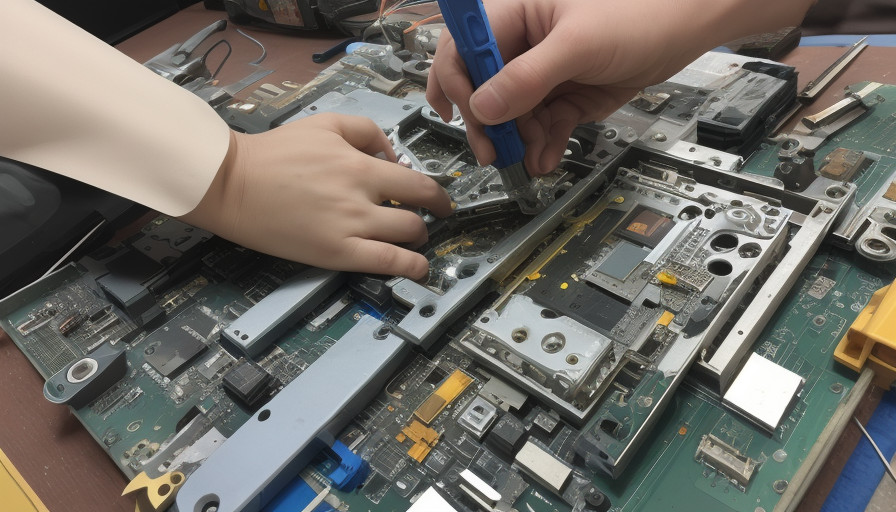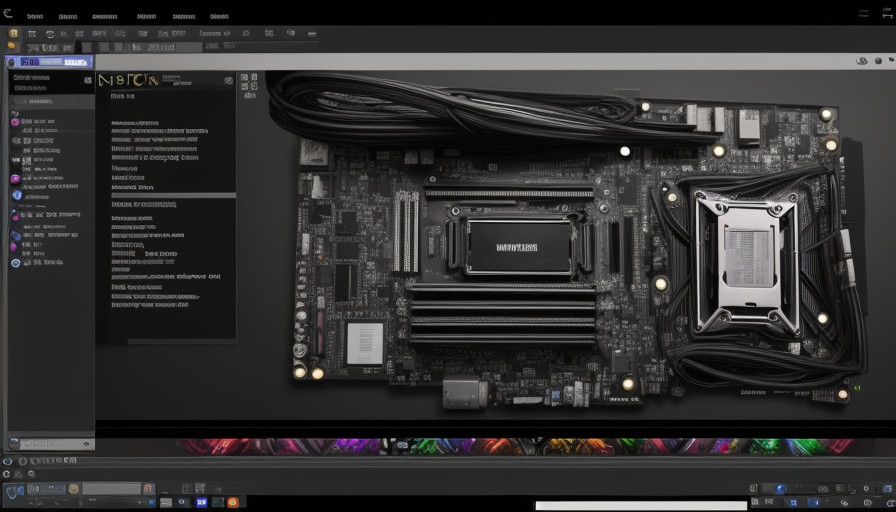Hi there! I’ve faced the same issue with my motherboard’s WiFi not working. I spent a lot of time checking settings and drivers. If you’re stuck with this problem too, let me share some easy steps to fix it!
If your WiFi on the motherboard is not working, first check if the WiFi is enabled in BIOS and ensure drivers are up to date. Also, verify the WiFi adapter is correctly seated. These steps often fix common connection issues.
In this article, we will discuss how to troubleshoot and fix issues with WiFi on your motherboard not working. We’ll cover essential steps like checking BIOS settings, updating drivers, and ensuring proper connections to help you restore your internet connection.
Understanding the Problem
Before diving into solutions, it’s important to understand what might be causing the WiFi on your motherboard to malfunction.
- Common Causes of WiFi Issues
WiFi problems can stem from a variety of sources, including outdated drivers, incorrect settings, hardware malfunctions, or interference from other devices. - Signs Your WiFi Is Not Working Properly
Symptoms include inability to connect to networks, frequent disconnections, poor signal strength, or the WiFi option being completely absent in your network settings.
Initial Troubleshooting Steps
Let’s start with some basic troubleshooting to rule out common issues.
- Check if WiFi Is Enabled
Sometimes, the simplest solution is the right one. Ensure that WiFi is enabled both in the BIOS settings and within your operating system. - Restart Your Router and Computer
Rebooting your router and computer can resolve many connectivity issues by resetting network settings and clearing temporary glitches. - Verify Network Connections
Make sure that your computer is within range of your WiFi network and that other devices can connect to the same network without issues.
Driver and Software Fixes
If basic troubleshooting doesn’t work, the next step is to check your drivers and software settings.
- Update WiFi Drivers
Outdated or corrupted drivers are a common cause of WiFi issues. Visit the motherboard manufacturer’s website to download and install the latest drivers. - Check for Windows Updates
Sometimes, system updates can fix compatibility issues with network adapters. Ensure your operating system is up-to-date. - Reset Network Settings
If you’re still having trouble, try resetting your network settings. This usually fixes problems caused by misconfigurations.
Advanced Troubleshooting
If the problem persists, you might need to dig a little deeper.
- Check for Hardware Conflicts
Conflicts between different hardware components can cause WiFi to malfunction. Use Device Manager to identify any conflicts and resolve them. - Test with a Different Network Adapter
If you have a USB WiFi adapter, try using it to see if the issue lies with the onboard WiFi. - Check BIOS Settings
Make sure the WiFi adapter is turned on in the BIOS settings. Sometimes, a simple setting can disable the WiFi functionality.
Hardware Inspection and Replacement
If software fixes don’t solve the problem, it might be time to inspect the hardware.
- Inspect the WiFi Antenna
Check that the WiFi antenna is securely connected to the motherboard. A loose or damaged antenna can significantly impact performance. - Look for Physical Damage
Check the motherboard for any signs of physical damage or wear. This might suggest that a repair or replacement is needed. - Consider a Replacement WiFi Module
If the onboard WiFi is faulty, you might need to replace the WiFi module. This is a more complex procedure that may require professional assistance.
Preventing Future Issues
Once your WiFi is back up and running, take steps to prevent future problems.
- Keep Drivers and Firmware Updated
Regularly check for updates to ensure your system runs smoothly and to prevent future issues. - Use Quality WiFi Equipment
Invest in a good quality router and ensure your WiFi equipment is up-to-date and capable of handling your network needs. - Avoid Interference
Keep your router away from other electronic devices that might cause interference, such as microwaves or cordless phones.
Installed new motherboard, built-in wifi not working
If your new motherboard’s built-in WiFi isn’t working, try these steps: make sure the WiFi is enabled in the BIOS, update or reinstall the network drivers, and check that the WiFi antennas are properly connected. These actions often fix the issue.
Why do so few new motherboards have WiFi built in?
Few new motherboards have built-in WiFi because many users prefer to use dedicated WiFi cards for better performance and range. Additionally, built-in WiFi can increase the motherboard’s cost and complexity. By leaving it out, manufacturers keep prices lower and allow users to customize their setups based on their specific needs.
B760 gaming plus wifi msi motherboard not showing any wifi options
If your MSI B760 Gaming Plus WiFi motherboard isn’t showing any WiFi options, try these steps:
- Review BIOS settings by restarting your PC and accessing the BIOS menu. Verify that the WiFi feature is activated.
- Update Drivers: Visit MSI’s website to download and install the latest WiFi drivers for your motherboard.
- Reinstall the Adapter: Make sure the WiFi adapter is properly seated on the motherboard.
- Check for Physical Switches: Some motherboards have a physical switch or button for WiFi; ensure it’s turned on.
If these steps don’t resolve the issue, there may be a hardware problem or a need for further troubleshooting.
PRO Z790-A MAX WIFI 7 – Wifi Not Working
If your PRO Z790-A MAX WIFI 7 isn’t showing WiFi options, try these steps:
- Check BIOS Settings: Restart your PC, enter the BIOS, and ensure the WiFi is enabled.
- Update Drivers: Download and install the latest WiFi drivers from MSI’s website.
- Inspect Hardware: Ensure WiFi antennas are connected properly and there are no loose cables.
If these steps don’t resolve the issue, you may need to explore further troubleshooting or consult MSI support.
Win 11 can’t detect my motherboard Wi-Fi & Bluetooth?
If Windows 11 can’t detect your motherboard’s Wi-Fi and Bluetooth, try these steps:
- Update Drivers: Go to the motherboard manufacturer’s website and download the latest drivers for both Wi-Fi and Bluetooth.
- Check BIOS Settings: Restart your PC, enter the BIOS, and ensure that both Wi-Fi and Bluetooth are enabled.
- Run Windows Troubleshooter: Go to Settings > System > Troubleshoot > Other troubleshooters, and run the troubleshooter for network and Bluetooth.
If these steps don’t work, there could be a hardware issue or a deeper software conflict.
FAQs
Can a WiFi issue be caused by a faulty motherboard?
Yes, if the onboard WiFi module is damaged or if there are issues with the motherboard’s connectivity features, it can cause WiFi problems.
How do I know if my WiFi drivers are up-to-date?
You can check for driver updates through the Device Manager in Windows or by visiting the motherboard manufacturer’s website.
Is it possible to fix a WiFi issue without replacing hardware?
In many cases, updating drivers, resetting network settings, or adjusting BIOS settings can resolve the problem without needing to replace any hardware.
Can a virus cause WiFi issues on my motherboard?
Yes, malware or viruses can interfere with network settings and cause connectivity issues. Running a full system scan can help detect and remove any threats.
What should I do if my WiFi still doesn’t work after trying everything?
If you’ve exhausted all troubleshooting steps and your WiFi still doesn’t work, consider seeking help from a professional technician or the motherboard manufacturer.
Why is my motherboards built in WiFi not working?
If your motherboard’s built-in WiFi isn’t working, check these: ensure WiFi is enabled in BIOS, update the drivers, and verify antenna connections. If these don’t fix it, there might be a hardware issue with the WiFi module.
How to enable WiFi on a new motherboard?
To enable WiFi on a new motherboard, enter BIOS to ensure WiFi is enabled, install the latest drivers, and check that WiFi is turned on in Windows settings.
How to enable WiFi in BIOS?
To enable WiFi in BIOS:
- Restart Your PC: Press the BIOS key (usually Del or F2) during startup.
- Navigate to Settings: Look for Integrated Peripherals or Onboard Devices.
- Enable WiFi: Find the WiFi option and set it to Enabled.
- Save and Exit: Save changes and exit the BIOS.
This will enable your motherboard’s built-in WiFi.
What to do if your motherboard doesn’t come with WiFi?
If your motherboard doesn’t come with WiFi, you can:
- Add a WiFi Card: Install a PCIe WiFi card for built-in WiFi functionality.
- Use a USB WiFi Adapter: Connect a USB WiFi adapter to get wireless connectivity.
- Check External Options: Consider using a network bridge or powerline adapter to connect to WiFi.
These options will help you add WiFi capabilities to your system.
How to check if Wi-Fi is turned on in BIOS?
To check if Wi-Fi is enabled in BIOS:
- Restart PC and enter BIOS (Del, F2, or Esc key).
- Find Wi-Fi Settings under Integrated Peripherals or Onboard Devices.
- Ensure Enabled, then save and exit.
How do I force enable Wi-Fi?
To force enable Wi-Fi:
- Enable in BIOS: Check BIOS settings to ensure Wi-Fi is turned on.
- Update Drivers: Install the latest drivers from the manufacturer’s website.
- Turn On in Windows: Go to Settings > Network & Internet > Wi-Fi and switch it on.
How to enable network card in BIOS?
To enable your network card in BIOS, restart your PC and enter BIOS by pressing Del, F2, or Esc during startup. Navigate to Integrated Peripherals or Onboard Devices, find the network card setting, and set it to Enabled. Save your changes and exit BIOS to apply the update.
How do I make my PC Wi-Fi enabled?
To make your PC Wi-Fi enabled, install a PCIe Wi-Fi card or plug in a USB Wi-Fi adapter. Ensure Wi-Fi is enabled in BIOS and install the latest drivers from the manufacturer’s website. This setup will get your PC connected to wireless networks.
Can BIOS disable Wi-Fi?
Yes, BIOS can disable Wi-Fi. If Wi-Fi isn’t working, check BIOS settings to ensure the Wi-Fi or network card option is set to Enabled. Disabling it here can prevent the system from recognizing the Wi-Fi hardware.
How to enable Wi-Fi from BIOS Dell?
To enable Wi-Fi from BIOS on a Dell PC, restart and press F2 during boot to enter BIOS. Navigate to Advanced or Integrated Peripherals, find the Wireless LAN option, and set it to Enabled. Save changes with F10 and exit.
How to enable WiFi in BIOS ASUS motherboard?
To enable Wi-Fi in BIOS on an ASUS motherboard, restart your PC and press Del or F2 to enter BIOS. Go to the Advanced tab, find Onboard Devices Configuration, and ensure Wireless LAN is set to Enabled. Save changes by pressing F10 and exit.
ASUS motherboard not detecting WiFi?
If your ASUS motherboard isn’t detecting Wi-Fi, enter BIOS by pressing Del or F2 during startup and ensure Wi-Fi is enabled under Advanced > Onboard Devices Configuration. Then, update your Wi-Fi drivers from the ASUS website and check the antenna connections.
Conclusion
WiFi issues on your motherboard can be a hassle, but with the right troubleshooting steps, you can usually get things working again. Start with basic fixes, check your drivers and settings, and don’t hesitate to inspect the hardware if necessary. With patience and persistence, you’ll have your WiFi back in no time.



Leave a Reply